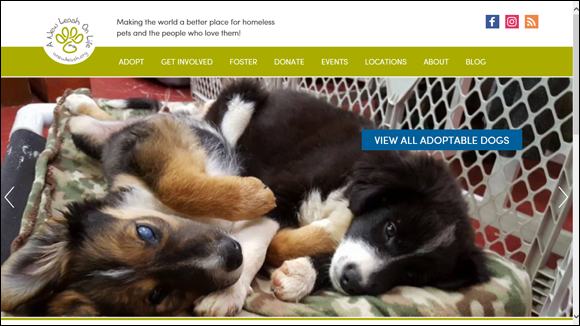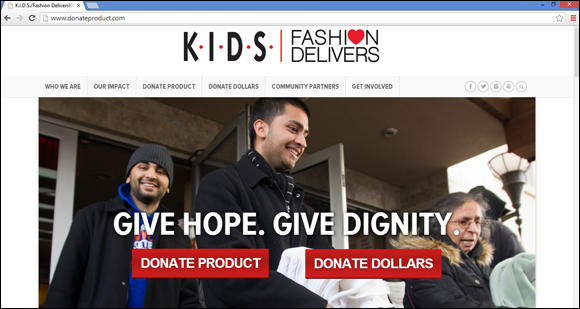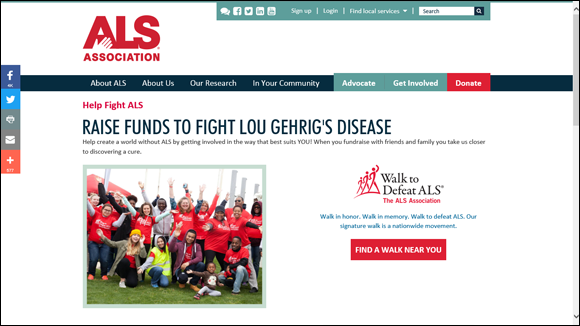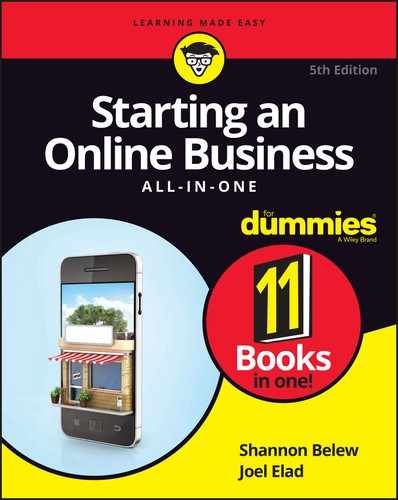Chapter 3
Growing an Active Donor Base: Your Virtual Community
IN THIS CHAPTER
![]() Attracting visitors to start building a donor base
Attracting visitors to start building a donor base
![]() Preparing your online strategy for attracting donors
Preparing your online strategy for attracting donors
![]() Moving your current supporters online and boosting activity
Moving your current supporters online and boosting activity
![]() Networking online for a good cause
Networking online for a good cause
Wouldn’t it be wonderful if you could put up your site, post your mission statement, and then watch as the generosity of strangers poured in for your cause? Well, it can happen — but not quite as easily as that! Getting people to donate to your cause takes effort on your part, mixed with a little bit of time and skill.
Creating a healthy online donor base is similar to organizing any other major fundraising campaign or event: It requires event planning, the ongoing help of volunteers and staff, a good marketing campaign, and (almost) flawless execution. The good news is that there is an entire online community of people who actively donate to causes on a regular basis. Tapping into this charitable community often means extending beyond your typical list of donors and volunteers. You not only raise more money from a new base of donors, but also you raise more broad-reaching awareness for your cause. In this chapter, we show you how to transfer those offline fundraising skills to your online efforts.
Building an Online Donor Base from Scratch
As with any commercial website, your online success depends on attracting customers. In this case, those customers are your donors, supporters, or constituents — or those potential donors that you aren’t even aware exist yet. At the end of the day, your goal is to bring these qualified visitors to your site.
These people are actively interested in your mission and are prepared to invest money, time, and good will in your cause. To find and keep this online donor base, try these three actions, which we call the G.E.E whiz factor:
- Get your site noticed.
- Engage passersby.
- Establish a relationship.
Get your site noticed
Develop a strategy to put your website on the map. This step requires actively promoting your site to existing members of your organization and introducing it to prospective donors based in local communities to those around the globe. The nonprofit animal rescue organization, A New Leash on Life (ANLOL), immediately shows visitors to its website (http://anewleash.org) all the ways they can get involved. From donating funds specifically to pay for vaccinations and surgery costs, to giving time for fostering pets and volunteering. The site also makes it clear how visitors can follow and engage with the organization on various social media sites and help them spread the word (see in Figure 3-1).

FIGURE 3-1: Giving donors clear and simple options to get involved and spread the word helps your cause and increases traffic.
Similarly, the global nonprofit, International Fund for Animal Welfare (IFAW) uses every opportunity to get supporters to help spread the word. For example, this nonprofit not only consistently provides opportunities across its website to donate or become active in its cause but also gets visitors to help drive more traffic (and potential donors) to its site. How? IFAW invites visitors to place an IFAW promotional banner on their own website or blog.
With ad banners, there are no forms to complete and no waiting periods for approval. Visitors simply choose the ad campaign and size of the banner they want to use and place it on their own website. It’s that easy! In a matter of minutes, the IFAW can have its logo, name, and cause on someone else’s site, all in an effort to help drive traffic and increase support. IFAW also has a Get Involved web page that shows a variety of ways to get involved, including everything from asking visitors to share the cause on social media sites to writing to U.S. senators to ask for help. As with the ad banners, the nonprofit makes it quick and simple to participate and help spread the word about its cause, while also attracting more visitors to its website!
Engage passersby
Give visitors to your site a reason to be involved in your organization right now. Rather than simply post your mission statement, use the site’s home page to highlight one of your success stories. Show how other donors have made a difference, and then list specific actions that visitors can take to help create another success story. Your home page is a natural location for providing information that inspires people. And placing action buttons and links nearby offers site visitors an easy way to get involved after your stories have worked their magic.
Take a look at the home page for K.I.D.S. Fashion Delivers (www.donateproduct.com), shown in Figure 3-2. As a nonprofit that assists children in need by providing clothing, shoes, and other new merchandise to clothe children in poverty, this organization uses images and clearly posted tabs and links to draw your attention to the ways it makes a difference in the lives of children. The home page also includes a How We Help section that shows how many companies have donated to the cause, the dollar value of product donations to date, and how many community agencies the organization has assisted through donations. These elements boost the organization’s credibility and increase confidence that donations are getting to the intended recipients.

FIGURE 3-2: Use images and statistics on your site to boost your organization’s credibility.
The home page also prominently shows donation buttons for both inventory donations and cash donations. Both a Donate Product button and a Donate Dollars button appear in the site’s top-level navigation bar and in various places on the home page. Between the heartwarming photos of people in need and stories of what the organization is doing to change lives for the better, you can’t help but want to at least find out ways you can help.
When visitors scroll down the page (which is also optimized for viewing on a mobile device), several places indicate the many ways to get involved with the organization, including:
- Giving cash donations through a Donate button.
- Providing donations of merchandise by completing an online inventory donation form.
- Finding a volunteer opportunity.
- Connecting with others who support the organization and staying up-to-date on events and news by participating in conversations on Twitter, Facebook, Pinterest, and YouTube. Because the site shows recent Twitter posts and provides links to these social networking sites, joining the online conversation is easy!
Establish a relationship
Getting people to take action once is a worthy goal; convincing them to become long-term donors is your real goal. To do that, use your website to keep people informed, to give them updates about how donations are being spent, and to expand their involvement into other areas of the organization.
The ALS Association, dedicated to fighting Lou Gehrig’s disease, brings home the G.E.E. whiz factor by establishing a relationship with its donors. ALS generated global awareness through an accidental viral campaign called the Ice Bucket Challenge. The viral video challenge not only raised millions of dollars over a single summer, but also spread incredible awareness and education about a disease that previously had little name recognition. The nonprofit has built upon that campaign’s success and promotes more ways to get to know the organization via its website. The site uses an image of an ice bucket in its main homepage banner — this immediately builds recognition with new followers who may have discovered the cause through the viral challenge. The site also invites donors to join its online community and shows specific ways to get involved from raising awareness to taking action.
Another G.E.E. whiz factor is that the site makes it clear how to get involved in a donor’s own, local community and actively contribute to the cause. Donors can start an event in their community to raise awareness with dollars going to their local chapter of ALS, or start an online fund in memory or recognition of someone they know who suffers from the disease. The site also clearly promotes all its social media communities and encourages visitors to participate with the association there, as well. You can see the many ways the organization promotes involvement on its site in Figure 3-3.

FIGURE 3-3: Keep donors coming back by helping them feel involved by offering multiple ways to stay connected.
Putting Together a Plan to Reach Donors
After you have a good idea of what it takes to get your site noticed and to keep visitors coming back for more (see the preceding section), you can put together a plan for your own online efforts. Your plan should include these action items:
- Identify your prospective donors. Whom do you want to target? Be specific — an “everyone” response doesn’t count. What does your typical contributor look like? Include descriptors such as age, gender, marital status, personal interests, or any other factors that typically reflect your most faithful donors.
-
Determine the desired donor actions. What do you want people to do after they find your website? Are you interested solely in cash donations? Or are you soliciting in-kind donations and supplies? Perhaps you want to recruit volunteers, too.
 When you determine all the possible actions, rank them in order of importance. Then you can decide how to place, or showcase, the opportunities on your site.
When you determine all the possible actions, rank them in order of importance. Then you can decide how to place, or showcase, the opportunities on your site. -
Describe the rules of engagement. How can you capture (and keep) the attention of your visitors? For example, consider the content you use on the site. Have people shared testimonials or success stories of how your organization has helped others? Use these stories to pique visitors’ interest, and follow them with instructions on how to get involved.
 Visitor awareness building and education are probably expected at this point. In fact, now you want to use those objectives to help elicit a specific online action — whether that’s making a contribution or having someone send your link to a friend.
Visitor awareness building and education are probably expected at this point. In fact, now you want to use those objectives to help elicit a specific online action — whether that’s making a contribution or having someone send your link to a friend. -
Define your donor pool. Geographically, where are your prospective donors located? Does it matter to you? Your organization might have a national or an international appeal, or your mission might benefit a regionalized population. Even if your scope is limited, other people might be interested in your cause. What about people who move away from your city and still have ties to the area? What about others who are simply affected by your cause? Deciding where your donors are likely to come from, or how far out you want to go to reach them, is an important element of your online marketing efforts.
 The Internet readily allows you to localize your marketing efforts, if you choose. Or you can decide to cast your net far and wide. If this issue is important to you, use geographic descriptions in your
The Internet readily allows you to localize your marketing efforts, if you choose. Or you can decide to cast your net far and wide. If this issue is important to you, use geographic descriptions in your <META>tags and page titles. That way, your organization is more likely to turn up in location-based results in search engines. Google also allows you to set an international geographic target for your website to improve location-specific search results (for more information, visithttps://support.google.com/webmasters/answer/62399?hl=en). Because IP addresses are used to help determine the location from which a person is searching for information, it’s important to take the steps needed to help your website appear in localized search results. The increasing use of mobile phones for conducting Internet searches makes local search results even more important for your business. - Establish donor hangouts. You want to create online marketing opportunities for your cause. To do that effectively, you need to know where your prospective donors are likely to hang out online. You can use these sites (social media sites or blogs, for example) to place banner ads, buy keyword advertising (paid searches), and post press releases.
- List giving partners. Exchanging links with sites that complement yours is an effective way to expand your reach. You can also partner with other sites by offering to provide content, place informational links to research, or simply promote a fundraising event.
- Provide action opportunities. Keep your donors involved by giving them lots of options to participate. Your plan should detail the ways in which people can not only donate money but also take action that makes them feel connected to your cause for the long haul.
- Specify follow-up. Plan to stay in touch with your online donors. E-mail messages, electronic newsletters, podcasts, blogs, social networking sites — the list of ways to keep connecting is almost endless. You can use some or all forms of communication (online and offline) to stay in touch with donors and build lasting relationships.
Converting the Faithful
Although most online plans attack the issue of recruiting new donors, don’t forget the ones who are already most familiar with you. Unless you have a recently launched nonprofit organization, you should have a fairly long list of existing supporters, which typically include
- Previous donors
- Full-fledged members or active donors
- Participants in, or attendees of, earlier fundraiser events
- Board members and volunteers (past and present)
- Community supporters and sponsors
If you played your cards right, you collected the e-mail addresses of these folks over the years. Even if you never had reason to use those addresses, you should still have them on file.
Your list of supporters and at least their current mailing addresses should be in a database. Regardless of whether you ever fully took advantage of this resource, you’re now in a great position to do so. Obviously, these people represent a built-in group of followers. If nothing else, they’re already aware of your organization and its mission. All you have to do is use your online initiative as a tool to step up their level of giving and involvement.
A great deal of recent e-philanthropy research indicates that people who give to charities over the Internet are likely to donate more — and do it more often. If you can convert a percentage of your offline contacts to online contributors, donations to your site might increase.
To see that happen, you have to reach out to everyone on your current list of names. Your objective is to get them active online.
How do you decide whether someone is willing to receive your message online? You have to ask, of course! To start converting your faithful followers, do the following:
- Send an electronic invite. Use your data bank of existing e-mail addresses and send a request for donors to visit your website. Making them aware of the site — and the ways they can stay involved online — is the first step in conversion.
- Reach out the old-fashioned way. Send a postcard, make an announcement in your print newsletter, or write a letter. If all you have is a street address, reach out with traditional mailers and invite donors to check out your organization online — and include a postage-paid return envelope that makes it easy for donors to send a contribution back to you.
- Register constituents online. For your next fundraising event, let folks register online. You then have the opportunity to collect updated e-mail addresses and get them accustomed to communicating with you over the Internet.
A few issues are still at play here. What happens if that piece of snail mail sits in a pile unnoticed? Too bad you didn’t have the recipient’s e-mail address! Then again, maybe your list of contacts contains old, outdated, or incorrect e-mail addresses, which are useless.
One solution for these types of obstacles is to pay to obtain valid e-mail addresses from your list of constituents. Several companies now offer services in which they match information about your existing list of donors with their current e-mail addresses. You don’t have to have existing e-mail addresses to use the service — this type of company can cross-reference information from other e-mail databases in order to find valid e-mail addresses.
You’re likely to find one of these three types of services helpful in your online business:
-
E-mail appending: You can cross-reference online databases to find someone’s e-mail address when all you have is a name, phone number, or street address.
When you’re choosing a company for e-mail-appending services, make sure that its process complies with guidelines issued by the Direct Marketing Association (DMA) and the Association of Interactive Marketing (AIM).
- E-mail validating: Your list of existing e-mail addresses might be outdated or invalid due to errors (such as typos). Companies can now verify e-mail addresses for you.
- Reverse appending: If you’re collecting e-mail addresses online, the addresses might be all the information you have on prospective donors. A reverse appending service matches e-mail addresses with valid street addresses.
Dozens of legitimate companies offer e-mail appending and related services. Prices for these services vary; many charge based on the number of valid e-mail addresses they find. Blackbaud (www.blackbaud.com), a company that specializes in assisting nonprofits, estimates that organizations usually convert 20 to 30 percent of their total donor lists to valid e-mail addresses. DonorPerfect (www.donorperfect.com) and DonorWorks (www.donorworks.com) are also viable programs.
Reaching Out to People Surfing for Charities
Obtaining working e-mail addresses is only one component of building an active base of online donors. Regardless of how many names you already have, you want to reach out to as many potential donors as possible.
Fortunately, a growing online trend is opening the door to millions of socially conscious Internet users. Social networking is a form of socializing through virtual communities. Some of the most recognizable social networking sites started with a focus toward entertainment, dating, and fostering friendships. Today, however, many social networking sites, such as LinkedIn, Facebook, Snapchat, Twitter, Instagram, Pinterest, and YouTube, have a much wider audience and are often used for business and nonprofit purposes. Even so, a derivative group of social networking sites is geared toward charitable giving and philanthropy in general. These sites connect individuals or large groups who share an interest in various causes. In addition to highlighting current nonprofit news and topics of interest, members can share their experiences in community message boards. Social networking sites also allow members to create their own personal pages (for free) to discuss the causes in which they’re active, to create and circulate online petitions, to donate to featured organizations, and to learn about different types of nonprofits.
Check out the sites in this list:
- Care2: With more than 36 million members, Care2 (
www.Care2.com) is one of a growing number of sites that are proliferating social awareness online through online petitions and other outreach initiatives. - Charity Navigator: A special feature of this site (
www.charitynavigator.org) is that it rates charitable organizations from its database of more than 8,000 organizations. Members can even track and compare charities on their own personalized web pages.
You must understand what makes outreach through social networking different from other types of outreach. At these sites, you don’t plaster Donate Now buttons across personal pages or aggressively solicit for paid memberships to your organization. Instead, these sites provide a forum to educate the public about your cause by interacting with your prospective donors and volunteers. Think of that forum as a low-key grassroots type of marketing tool, and get creative!
You can get involved with these types of sites and spread your organization’s mission in several ways:
- Sign up. Become a member of the site. (Signing up is usually free.) Create your own personal page to discuss your cause, connect to similar groups, and send messages to friends in your online network.
- Actively contribute. Join the discussions on the message boards. Find out what people are talking about and, when it’s appropriate, let them know what your organization does and how they can get involved.
- Provide content. Submit articles for the site’s content, send press releases, and forward news briefs with information pertaining to your cause (such as the status of current legislation).
- Become a sponsor. With millions of active and vocal members, your site’s marketing dollars are likely to go far when you become a sponsor or paid advertiser on these types of sites.
- Submit your charity. For sites that keep logs or reviews of nonprofit organizations, always send in the necessary information to keep your cause on the list.
